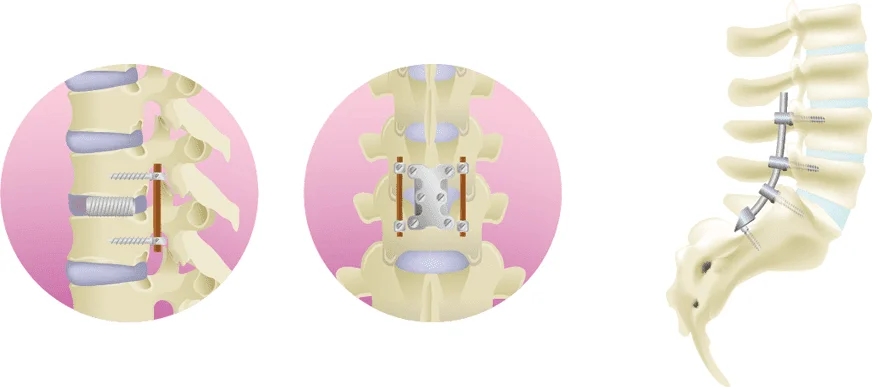Column Things to Know Prior to Lumbar Spinal Stenosis Surgery: Preparation, Surgery and Rehabilitation Duration Until One’s Return to Normal Life
June 1, 2023
Spinal canal stenosis is a condition in which a narrowing of the nerve pathway occurs within the spine (i.e. the spinal canal).
The spinal canal narrows due to age-related changes in the intervertebral discs, or due to the spinal canal being compressed by factors such as spondylolisthesis in the spine or disc herniation. As early as around the age of 16, the intervertebral discs begin to be affected by the great strain placed daily on the lower back. As the intervertebral discs progressively deteriorates, their cushioning function also declines, putting increasing pressure on the bones, which then begin to deform. Eventually, the spinal canal, which is the space where the nerves are located, starts to narrow, compressing the nerves.
Treatment for spinal stenosis may involve the use of block injections, but if the pain and numbness are severe, surgical treatment may be considered.
In this article, we will discuss surgery for lumbar spinal stenosis.
Surgery for spinal stenosis
Lumbar spinal stenosis surgery generally involves a lumbar laminectomy and spinal fusion.
Lumbar laminectomy is performed using endoscopy, under general anesthesia, by performing an incision in the skin of the back, and involves removing part of the lamina and the thickened ligamentum flavum to relieve pressure on the nerves and widen the spinal canal.
Spinal fusion surgery may be performed on its own or after a lumbar laminectomy. Under general anesthesia, the skin on the back is cut open, the deteriorated intervertebral disc is removed, a cage filled with bone taken from the hipbone is inserted in its place, the spine is realigned, and finally the vertebrae are fixed in place with screws and rods.

Preparation until Surgery
Once a spinal surgery has been scheduled, the patient will need to prepare for the surgery up to the day of the operation. Many medical facilities ask that you stop smoking, drinking alcohol, and lose weight.
Smoking is said to worsen the healing of wounds after surgery and increase the risk of infection, as it impairs the blood flow throughout the body. The sooner you stop smoking, the better, and it is best to stop at least one month before surgery.
Drinking alcohol puts a strain on the liver, and if the liver function is poor, the risk of infection increases, which also affects recovery after surgery. Generally, you are asked to stop drinking alcohol about a week before surgery.
If you are overweight, the operating field may be too narrow, making surgery more difficult, and the risk of complications after surgery may increase, so the medical facility may ask you to lose weight before surgery.
Duration of surgery
The time needed to perform a lumbar laminectomy is about 1.5 hours per vertebra.
The operation time for a spinal fusion may sometimes be as short as 1 hour, but it can also take between 2 and 3 hours.
Rehabilitation until returning to normal life
In some cases, hospitalization may be required for as long as 2 weeks after spinal surgery. The more sites operated on, the longer the hospitalization period.
From the day after surgery, you will start by making sure you can get up and sit down from your bed, and if your recovery is going well, you will move on to practicing walking and other everyday movements.
The time it takes to return to your normal life will be long, and it will take time to reintegrate into society after surgery.
Our clinic’s treatment
Our hospital uses the Cellgel Method to treat spinal stenosis.
Since spinal stenosis is caused by the central component of the intervertebral disc protruding due to a crack in the disc, and the protruding part narrowing the spinal canal, if the crack in the disc is not repaired, there is a real possibility that the hernia will recur or the spinal canal will narrow again.
With our clinic’s Cellgel Method, a drug fills in the cracked part of the intervertebral disc is injected, and as it turns into a gel, it fills in the cracks, thus providing a fundamental treatment. The volume of the intervertebral disc does not decrease, and the drug remains in the intervertebral disc as a gel-like implant after treatment, so the intervertebral disc is preserved.

Duration of treatment
The treatment with the Cellgel Method takes about 20 minutes per disc.
You can return home on your own on the same day of treatment, so there is no need for hospitalization involved.
Rehabilitation until the patient’s return to normal life
After treatment, you can perform light activities the next day, while being careful to refrain from doing movements that put a strain on your lower back.
You will need to avoid sports and heavy labor for about a month.
If you have been diagnosed with spinal stenosis and have concerns about it, or if you would prefer to avoid spinal surgery, please consider a consultation at our hospital.
Related articles
The Different Symptoms of Spinal Canal Stenosis: If You Have Any of These, It’s a Red Flag!



